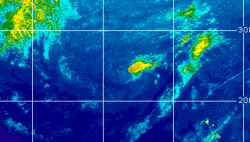Storms as they move northward generally tend to grow in size. The same often holds for those that undergo eyewall replacement cycles; the system as a whole grows as a new, larger eyewall forms and replaces the smaller one. External influences can play a role upon this as well, but it's largely driven by inner-core changes.
We've seen three major storms this year -- Emily, Dennis, and now Katrina -- all undergo eyewall replacement cycles shortly before landfall. Generally, these came after periods of rapid intensification before landfall, as is expected for such storms. The very favorable conditions in the central Gulf lead, in all three cases, to scenarios favorable for the storms to ramp up rapidly. As a result, eyewall replacement cycles likely (since we don't know a *lot* about eyewall cycles, I have to qualify that statement like so) had an increased chance of occurring, leading to temporary weakening. As the storms neared the coast, the shallower waters -- not necessarily cooler, except in perhaps Dennis' case -- and the residual effects of the eyewall cycle plus (not always the case) increasing interaction with the midlatitudes lead to a decreased propensity to come in quite as strong as the storms once were.
Ultimately, it's partially luck and partially science at play here. Each storm stil packed quite the punch, just perhaps not as much as it could have. And, it's not always going to happen like this in the future, though a lot of times Gulf storms late in the season do weaken due to very shallow depths of warm water. Nevertheless, Katrina is going to go down in the record books; it may not have been the catastrophe that many feared, but it still did billions of dollars in damage to New Orleans, Biloxi, Gulfport, Pascagoula, Mobile, and all areas in between and further inland. We'll be cleaning up from this one -- and trying to understand why the track shifted less than three days before landfall like it did and trying to see if the storm could have maintained itself (absent an eyewall cycle) as it approached land -- for many months. Best of luck to all of those in the affected areas.
--------------------
Current Tropical Model Output Plots
(or view them on the main page for any active Atlantic storms!)
|



 Flat
Flat




